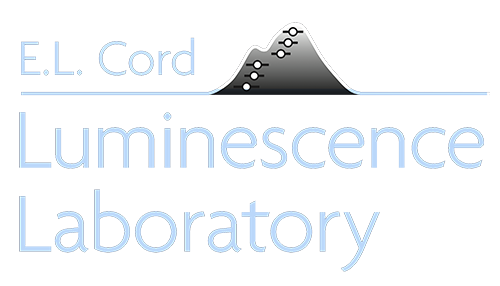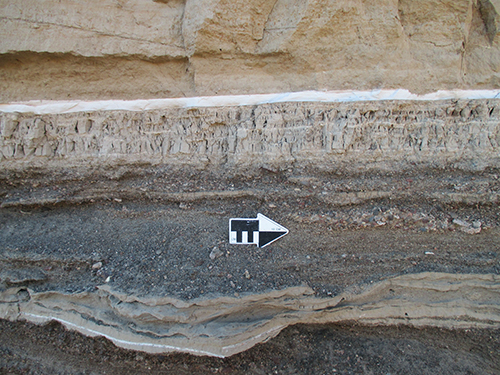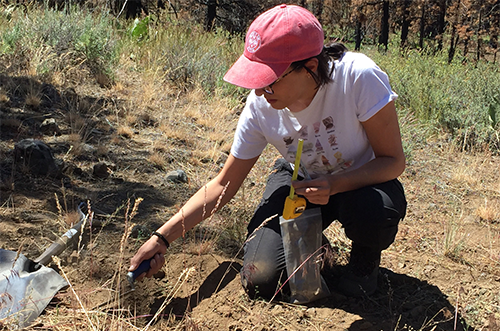
DRILL
DRI Luminescence Research Lab
The DRI Luminescence Research Laboratory (DRILL) is located at DRI’s northern campus in Reno, NV and offers a broad spectrum of luminescence dating capabilities, including optically stimulated luminescence (OSL) and thermoluminescence (TL) techniques. The DRILL is a research laboratory dedicated to fundamental investigations in the luminescence properties of earth materials, and to the application of luminescence dating techniques to geomorphological, geological, and archaeological problems.
The DRILL welcomes collaboration with
TEAM

Dr. Kathleen Rodrigues, Director of the DRI Luminescence Research Laboratory
Kathleen is a Quaternary geochronologist that specializes in radiation exposure dating techniques including optically stimulated luminescence, thermally stimulated luminescence and electron spin resonance. Her research interests are focused on the development and application of luminescence dating methods to address questions in Quaternary geomorphology, paleoclimatology, and archaeology. Her recent work has focused primarily on the development of novel methods for dating eruption events in the Great Basin and defining the timescales over which tephra reworking occurs in the landscape.
PROJECTS

PI: S. Bacon and K. Rodrigues
Sponsor: National Science Foundation (P4CLIMATE)
Holocene precipitation and snowpack reconstruction of the south-central Sierra Nevada from integrated shoreline, glacial, and watershed-lake hydrological modeling
Instrumental records of precipitation, temperature, and surface-water flow in many areas of the western U.S. are often limited to the past century, but long-term estimates of streamflow variability are critical for managing water resources and mitigating impacts of floods and droughts. Deciphering patterns of background precipitation and temperature variability from underlying anthropogenic forcing is only possible by understanding the pattern of natural rapid climate change throughout the Holocene (i.e., last 11,500 years ago). The scientific objective of this project is to further our understanding of past regional and seasonal climate. By using an interdisciplinary approach that includes studying and determining the age of paleolake shorelines and performing watershed-lake hydrologic modeling of a chain of intermittently connected lakes of the paleo-Owens River-Lake System (Owens, China, Searles Lakes), the researchers aim to reconstruct precipitation and snowpack of the south-central Sierra Nevada, California during the Holocene.

PI: K. Rodrigues
Sponsor: National Park Service, National Center for Preservation Technology & Training
Developing a novel isochron-based luminescence method for dating museum ceramics
Ceramics are ubiquitous in the global archaeological record, and placing ages on these commodities is of significant importance to our understanding of human history. Radiocarbon dating is often used to define the age of archaeological materials but requires that organic materials are available and their temporal association within the archaeological context be known. Luminescence dating of ceramics is a well-established technique that avoids the ambiguity of the association between dated events and targeted events, but in its conventional application suffers from two main limitations: (1) the inherently destructive nature of the technique, and (2) the requirement for in-situ data to be collected from the burial environment; once the ceramic is removed from its archaeological context, this information (and thus the potential for dating) is lost. The proposed project seeks to test a minimally destructive isochron-based luminescence dating approach that would enable a luminescence age to be determined independently of any knowledge of the burial environment, thus providing a new opportunity to date museum samples.

PI: K. Rodrigues
Sponsor: National Science Foundation (Sedimentary Geology and Paleobiology)
Testing the Impact of Reworking on the Isochronicity of Tephras Deposited in Diverse Sedimentary Environments
The isochronous deposition of tephra is a fundamental assumption that impacts tephrochronology and interpretations about paleoclimate and reconstructions of landscape dynamics, such as lake-level fluctuations, that are made from tephra correlations. A second outstanding problem in tephrachronology is the lack of a reliable dating methods to date tephras that are older than the 35 ka upper limit for reliable radiocarbon and younger than the 120 ka lower limit of reliable K/Ar and 40Ar/39Ar dating techniques. The proposed research tests the isochronicity of deposition and the timescales over which postdepositional reworking of tephra occurs through well-established luminescence dating techniques and tests new experimental techniques to directly date volcanic glass in tephras. Owing to the wealth of existing data and to conflicting interpretations of lake-level of some tephras in the Lahontan basin, it is an ideal study site to test the broader assumptions about tephra isochronicity and reworking. Through this research, we will investigate fundamental questions regarding how the stratigraphic record in terrestrial sedimentary environments is deposited and determine the level of confidence that can be placed on tephra beds as isochronous time-stratigraphic markers and develop new luminescence methods to date volcanic materials.

PI: Kathleen Rodrigues
Sponsor: Desert Research Institute
Exploring the Application of Luminescence for Tracing Temperature Changes in Soils Affected by Wildfires
The role of wildfires on soil properties is a complex and generally less studied phenomenon relative to the aboveground effects of fire. Soil heating resulting from wildfires has a number of potential impacts on soil constituents and their properties including the loss or reduction of soil structure and organic matter, reduced porosity, and increased pH. Because fire damage to the soil system increases with increasing soil temperature, the soil temperature reached during a fire is an important factor in predicting post-fire erosion and debris flow hazards, the capacity for plant regeneration, and thus the recovery potential of burned areas. This research project serves to evaluate the application of thermoluminescence to post-fire soil temperature reconstruction by leveraging a well-established temperature-luminescence sensitivity relationship that exists for quartz.
RESEARCH & PUBLICATIONS
Loendorf, L., & Rodrigues, K. (2025). The Implications of Fremont Pottery in Montana. Arts, 14(1), 17.
Kovach, T. Z., Petrosyan, A., Wilkinson, K. N., Raczynski-Henk, Y., Rodrigues, K., Frahm, E., Beverly, E., Gill, J. P., Gasparyan, B., Adler, D. S. (2025). Contextualizing the Upper Paleolithic of the Armenian Highlands: New Data from Solak-1, Central Armenia. Journal of Human Evolution, 199, 103632.
Langston, A.L., Marcotte, A.L., Neudorf, C.M., Rodrigues, K. and Keen-Zebert, A. (2025), Interpreting depositional environments from modern floodplain sediments using optically stimulated luminescence. Boreas, 54, 14-33.
Wolfe, S. A., Demitroff, M., Neudorf, C.M., Woronko, B., Chmielowska-Michalak, D., Lian, O.B. (2023). Late Quaternary eolian dune-field mobilization and stabilization near the Laurentide Ice Sheet limit, New Jersey Pine Barrens, eastern USA. Aeolian Research, 62, 100877.
Rodrigues, K., Keen-Zebert, A., Shepherd, S., Hudson, M. R., Bitting, C. J., Johnson, B. G., & Langston, A. (2023). The role of lithology and climate on bedrock river incision and terrace development along the Buffalo National River, Arkansas. Quaternary Research, 1-15.
Chupik, C., Koehler, R., & Keen‐Zebert, A. (2022). Complex Holocene Fault Ruptures on the Warm Springs Valley Fault in the Northern Walker Lane, Nevada–Northern California. Bulletin of the Seismological Society of America, 112(1), 575-596.
Rodrigues, K., Stapor, F. W., Rink, W. J., Dunbar, J. S., & Doran, G. (2022). A 5700-year-old beach-ridge set at Cape Canaveral, Florida, and its implication for Holocene sea-level history in the southeastern USA. The Holocene, 32(1-2), 40-56.
Rodrigues, K., Huot, S., & Keen-Zebert, A. (2022). Exploring the application of blue and red thermoluminescence for dating volcanic glasses. Radiation Measurements, 153, 106731.
Bacon, S. N., Bullard, T.F., Kimball, V., Neudorf, C.M., Baker, S.A., (2022). Landscape response to hydroclimate variability shown by the post-Bonneville Flood (~18 ka) fluvial-geomorphic history of the middle Snake River, Idaho, USA. Quaternary Research, 1-23.
Mahan, S.A., Rittenour, T.M., Nelson, M.S., Ataee, N., Brown, N., DeWitt, R., Durcan, J., Evans, M., Feathers, J., Frouin, M., Guérin, G., Heydari, M., Huot, S., Jain, M., Keen-Zebert, A., Li, B., Lopez, G., Neudorf, C., Porat, N., Rodrigues, R., Sawakuchi, A.O., Spencer, J.Q.G., Thomsen, K., (2022). Guide for interpreting and reporting luminescence dating results. GSA Bulletin 2022, doi: https://doi.org/10.1130/B36404.1.
Lancaster, N., Bacon, S.N., Bullard, T.F., Neudorf, C.M., Keen-Zebert, A.K., Decker, D.L., Boggs, M.L., (2021). Tectonic, hydrogeologic, and climatic controls on Late Holocene dune formation, China Lake Basin, Indian Wells Valley, California, USA. Quaternary Research, 1–17.
Marcotte, A.L., Neudorf, C.M., Langston, A.L., (2021). Lateral bedrock erosion and valley formation in a heterogeneously layered landscape, Northeast Kansas. Earth Surface Processes and Landforms 46(11), 2248–2263.
Cheng, F., Zuza, A.V., Haproff, P.J., Wu, C., Neudorf, C., Chang, H., Li, Xiangzhong, Li, Bing, Li. (2021). Accommodation of India-Asia convergence via strike-slip faulting and block rotation in the Qilian Shan fold thrust belt, northern margin of the Tibetan Plateau. Journal of the Geological Society 178 (3), doi: https://doi.org/10.1144/jgs2020-207.
Gray, H. J., Keen-Zebert, A., Furbish, D. J., Tucker, G. E., & Mahan, S. A. (2020). Depth-dependent soil mixing persists across climate zones. Proceedings of the National Academy of Sciences, 117(16), 8750-8756.
McIntosh, P., Neudorf, C., Lian, O.B., Slee, A.J., Walker, B., Eberhard, R., Doyle, R., Price, D.M., Dixon, G. (2020). Quaternary and early Holocene aeolian deposits of Tasmania and their climatic implications. Quaternary Research, 1–24.
Bacon, S. N., Bullard, T. F., Keen-Zebert, A. K., Jayko, A. S., & Decker, D. L. (2020). Spatiotemporal patterns of distributed slip in southern Owens Valley indicated by deformation of late Pleistocene shorelines, eastern California. Bulletin, 132(7-8), 1681-1703.
Davis, L.G., Madsen, D.B., Valdivia, L.B., Higham, T., Sisson, D.A., Skinner, S.M., Stueber, D., Nyers, A.J., Keen-Zebert, A., Neudorf, C.M., Cheyney, M., Izuho, M., Iizuka, F., Burns, S.R., Epps, C.W., Willis, S.C., Buvit, I. (2019). Late Upper Paleolithic occupation at Cooper’s Ferry, Idaho, USA shows Americas settled before ~16,000 years ago. Science 365, 891–897.
Fulop, E. C., Johnson, B. G., & Keen-Zebert, A. (2019). A geochronology-supported soil chronosequence for establishing the timing of shoreline parabolic dune stabilization. Catena, 178, 232-243.
Williams, T. J., Collins, M. B., Rodrigues, K., Rink, W. J., Velchoff, N., Keen-Zebert, A., … & Prewitt, E. R. (2018). Evidence of an early projectile point technology in North America at the Gault Site, Texas, USA. Science Advances, 4(7), eaar5954.
Furbish, D. J., Schumer, R., & Keen-Zebert, A. (2018). The rarefied (non-continuum) conditions of tracer particle transport in soils, with implications for assessing the intensity and depth dependence of mixing from geochronology. Earth Surface Dynamics, 6(4), 1169-1202.
Furbish, D. J., Roering, J. J., Keen‐Zebert, A., Almond, P., Doane, T. H., & Schumer, R. (2018). Soil particle transport and mixing near a hillslope crest: 2. Cosmogenic nuclide and optically stimulated luminescence tracers. Journal of Geophysical Research: Earth Surface, 123(5), 1078-1093.
Mercier, N., Rink, W. J., Rodrigues, K., Morley, M. W., Vander Linden, M., & Whallon, R. (2018). Radiometric dating of the Crvena Stijena sequence. In Crvena Stijena in cultural and ecological context: Multidisciplinary archaeological research in Montenegro (pp. 140-149). Podgorica: Montenegrin Academy of Sciences and Arts: National Museum of Montenegro, 2017.
Beeson, H. W., McCoy, S. W., & Keen-Zebert, A. (2017). Geometric disequilibrium of river basins produces long-lived transient landscapes. Earth and Planetary Science Letters, 475, 34-43.
Keen‐Zebert, A., Hudson, M. R., Shepherd, S. L., & Thaler, E. A. (2017). The effect of lithology on valley width, terrace distribution, and bedload provenance in a tectonically stable catchment with flat‐lying stratigraphy. Earth Surface Processes and Landforms, 42(10), 1573-1587.
Larkin, Z. T., Tooth, S., Ralph, T. J., Duller, G. A., McCarthy, T., Keen-Zebert, A., & Humphries, M. S. (2017). Timescales, mechanisms, and controls of incisional avulsions in floodplain wetlands: Insights from the Tshwane River, semiarid South Africa. Geomorphology, 283, 158-172.
Rodrigues, K., Rink, W. J., Collins, M. B., Williams, T. J., Keen-Zebert, A., & Lόpez, G. I. (2016). OSL ages of the Clovis, Late Paleoindian, and Archaic components at Area 15 of the Gault site, central Texas, USA. Journal of Archaeological Science: Reports, 7, 94-103.
Keen-Zebert, A., Tooth, S., & Stuart, F. M. (2016). Cosmogenic 3He measurements provide insight into lithologic controls on bedrock channel incision: examples from the South African interior. The Journal of Geology, 124(3), 423-434.
Nicoll, K., & Keen-Zebert, A. (2016). Initial chronological determinations at an Archaic site discovered near Stockton, Utah. Journal of Archaeological Science: Reports, 6, 418-423.
Keen-Zebert, A., (2015) Luminescence, Fluvial Sediments. In Rink, W.J., Thompson, J.W. (Eds.) Encyclopedia of Scientific Dating Methods, Springer-Verlag, Berlin-Heidelberg. 465-469. doi:10.1007/978-94-007-6326-5_3-1
Tooth, S., McCarthy, T., Rodnight, H., Keen-Zebert, A., Rowberry, M., & Brandt, D. (2014). Late Holocene development of a major fluvial discontinuity in floodplain wetlands of the Blood River, eastern South Africa. Geomorphology, 205, 128-141.
Keen-Zebert, A., Tooth, S., Rodnight, H., Duller, G. A. T., Roberts, H. M., & Grenfell, M. (2013). Late Quaternary floodplain reworking and the preservation of alluvial sedimentary archives in unconfined and confined river valleys in the eastern interior of South Africa. Geomorphology, 185, 54-66.